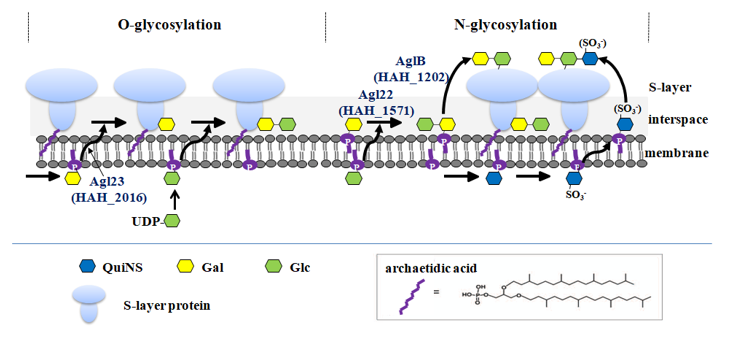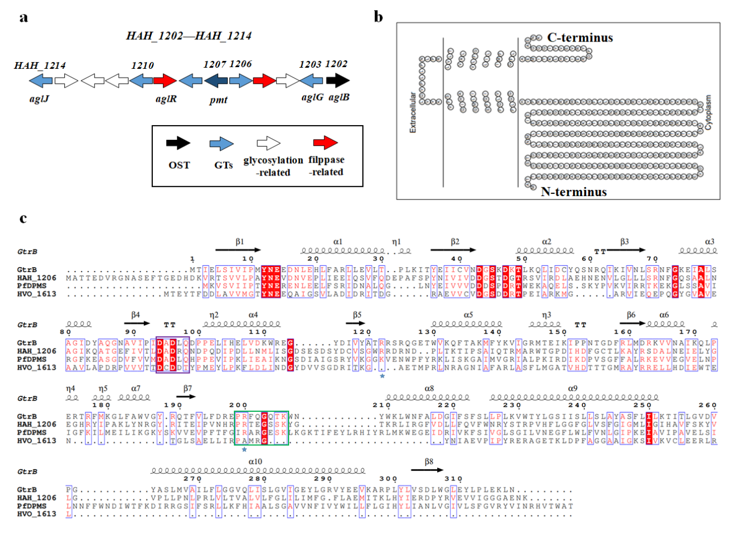On January 12, 2023, Prof. JIN Cheng's research group from the State Key Laboratory, Institute of Microbiology of the Chinese Academy of Sciences (IMCAS) published a research article entitled “AepG is a glucuronosyltransferase involved in acidic exopolysaccharide synthesis and contributes to environmental adaptation of Haloarcula hispanica” in Journal of Biological Chemistry. In this article, the authors reported the first dolichol phosphate glucuronosyltransferase identified in any of the three domains of life.
In recent years, the study of extremophiles has gained increasing attention, not only from an evolutionary point of view but also for exploring the function of polysaccharides produced by these microorganisms. Using an extremely halophilic archaeon Haloarcula hispanica as a model, previously Prof. Jin’s research group characterized the protein glycosylation (Glycobiology, 25: 1150, 2015) and identified the genes invovled in protein glycosylation, including a novel flippase Agl23 (Molecular Microbiology, 114: 762, 2020) (Figure 1). They also found that Har. hispanica can produce an acidic exopolysaccharides (EPS) and identified two genes (HAH_1662 and HAH_1667) are involved in the synthesis of the acidic EPS (Archaea, 2017). However, the complete pathway for synthesis of this EPS remains to be investigated.

Figure 1. Identification of the pathway for glycostylation of the S-layer protein in Har. hispanica (Glycobiology, 2015; Molecular Microbiology, 2020).
In this study, Prof. Jin’s research group initially found that the HAH_1202-HAH_1214 cluster in Har. hispanica genome contains several genes encoding putative glycosyltransferases potentially involved in protein glycosylation and/or EPS synthesis, including HAH_1206. Using genetic and biochemical approaches, they confirmed that AepG encoded by HAH_1206 is a dolichol phosphate (DolP) glucuronosyltransferase responsible for the synthesis of DolP-GlcA, which is a donor for the synthesis of the acidic EPS of Har. hispanica and vital for the adaptation of Har. hispanica to a high salt environment. This finding not only help us to understand the function of the acidic EPS in archae, but slao offers a starting point for further investigation into the diverse pathways of EPS biosynthesis and may have a biotechnological potential for the biosynthesis of functional EPSs.

Figure 2. Identification of AepG (HAH_1206) as a dolichol phosphate glucuronosyltransferase responsible for the synthesis of DolP-GlcA (Journal of Biological Chemistry, 2023).
This study is sponsored by the the National Natural Science Foundation of China (NSFC-ISF Joint Research Program 31661143033) and the Israel Science Foundation (2193/16). Prof. JIN, Cheng and Dr. YANG, Jinghua are corresponding authros. PEI, Caixia and LU, Hua share the first-authorship. Prof. Jerry Eichler (Department of Life Sciences, Ben Gurion University of the Negev, Israel) and Prof. Ziqiang Guan (Department of Biochemistry, Duke University Medical Center, USA) made important contributions to this research.
Research article: Pei, C.#, Lu, H.#, Ma, J., Eichler, J., Guan, Z., Gao, L., Liu, L., Zhou, H., Yang, J.*, Jin, C.* (2023) AepG is a dolichol phosphate glucuronosyltransferase involved in acidic exopolysaccharide synthesis and contributes to environmental adaptation of Haloarcula hispanica. J. Biol. Chem., published online, 102911. https/doi.org/10.1016/ j.jbc.2023.102911.